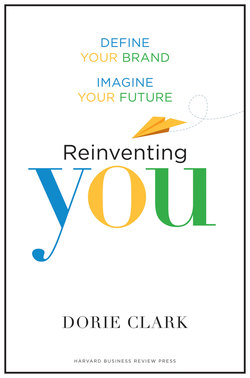Читать книгу Reinventing You - Dorie Clark - Страница 7
На сайте Литреса книга снята с продажи.
CHAPTER 1 The New Branding Landscape
ОглавлениеAre you where you want to be professionally? Whether you want to advance faster at your company or change jobs or even careers, one thing is clear: no one wants to spend a lifetime doing a job they hate. To succeed in today’s competitive job market and build a career that leverages your unique passions and talent, it’s almost certain that at some point you’ll need to reinvent yourself professionally—and ensure that others recognize the powerful contribution you can make.
After all, it’s clear that the era of gold watches and lifetime employment is over. How many people do you know who are lifers at a company? For better or worse, people today skip around professionally, forced by layoffs or seeking a better title or salary. Even for those who would have wanted to make a career at one company, the options are limited. Harvard Business School Professor Thomas DeLong attributes this, in part, to a precipitous decline in professional mentorship over the past several decades. As senior executives were forced to take on increased responsibilities, they stopped making time to cultivate rising talent. The result, says DeLong, is executives who “start to be suspicious about the organization and see themselves as free agents rather than saying, ‘I can stay at this firm for the next thirty years.’” Rapid job turnover has now become standard.
Even if they stay with the same company or industry, professionals still need to reinvent themselves to keep up with the rapid pace of corporate change. “How are you adapting and approaching your next reinvention curve?” asks Steven Rice, the executive vice president of human resources at Silicon Valley powerhouse Juniper Networks, of job applicants. “How are you staying relevant and competitive? People have to reinvent themselves to fit into the new context of work.”
Amid this new landscape of frequent job and career changing, people are increasingly working later in life. Sometimes that’s due to preference, and sometimes to necessity. (Between the recession years of 2007 and 2010, the number of working Americans fifty-five and over grew by nearly 8 percent—the only group whose workforce participation rates increased.)1 As AARP’s policy director told the National Journal, “the resources they were counting on to retire just aren’t there.”2 That means even more opportunities, or requirements, to reinvent yourself over the course of your career.
The lengthening careers of baby boomers also have an impact on their kids, millennials struggling to find their way in the workforce and hitting a wall of more experienced candidates eager for the same jobs. In 2011, the percentage of employed young people hit a sixty-year low.3 If your early jobs don’t reflect your desired future path, it’s essential to be strategic about how you’re positioning yourself and your experience in order to maneuver to where you want to be.
As Henry Wadsworth Longfellow noted, “we judge ourselves by what we feel capable of doing, while others judge us by what we have already done.” So when you’re a finance guy who moves into marketing, a venture capitalist who wants to become a career coach, or an executive trying to win a promotion to the next level, your path may make perfect sense to you, but that doesn’t mean it’s clear to everyone else.
Reinvention, and overcoming past perceptions, can be a daunting process. Not everyone needs to rebrand himself professionally, of course. If you do have a long-term career at your company and are happy with your trajectory, you may not need to worry about it. But for many of us, that luxury doesn’t exist.
This book is intended to help executives at all stages of their careers who want something different and better in their professional lives—and know there has to be a more strategic way to do it. You may be struggling to find a toehold in an inhospitable economic climate, like Johnna, a young professional I’ll profile later who was forced to bide her time with retail jobs instead of hopping on the career fast track. You may be facing a crisis in your industry that’s forcing you to consider new options, like Tom, who was laid off after more than two decades as a newspaper reporter. You may, like Dan, have to fight back against misconceptions about you in order to succeed at your company. You may be looking to build new skills and explore new interests, like Karen, a corporate attorney who realized she desperately needed a change. This book is an invitation to ask what you want out of life.
When Should You Reinvent Yourself Professionally?
You’re at a new phase in life and you want to be known for something different.
You’ve been laid off and need to ensure you’re in the best position possible to land a new job quickly.
You want to move up in your company, and you need to take control of your reputation.
You’ve been trying to win a promotion, but feel you’re being held back by misconceptions about what you’re capable of.
You’d like to move into a different area of your company, perhaps from legal to human resources, or from sales to finance.
You’re just starting out in your career and haven’t built up a powerful résumé yet, so you need to find another way to stand out.
You’re changing careers and need to make a compelling case that your unusual background is an asset, not a liability.
